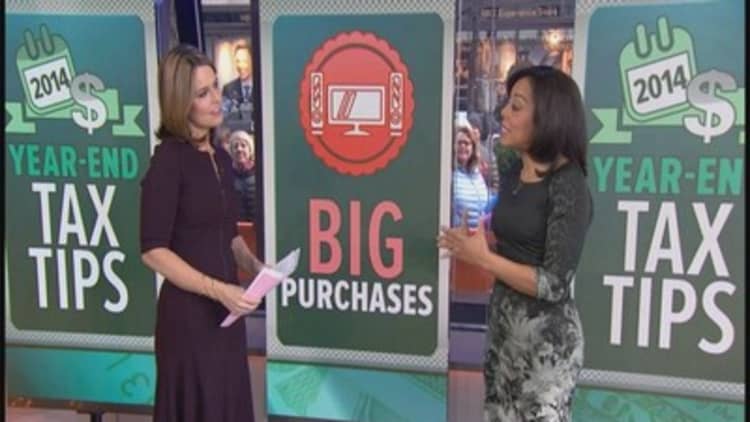It's harvest season for your portfolio, at least if you are hoping to save on taxes.
December is the time when many people think about harvesting tax losses to cut their tax bills (though it's possible any time of year). Selling stocks or other assets that have lost value generates a reduction in your tax liability that you can use to offset capital gains.
The market's recent ups and downs have been unsettling, but the silver lining is that any losses in your portfolio may make April 15 considerably less unpleasant if you decide these are assets you no longer want to hold.
Read More6 ways to lower your 2014 tax bite
"Do I have some security that I just don't fundamentally believe in any more and I want to reduce my allocation or get out? Do I have an asset allocation that is out of balance?" said John Sweeney, executive vice president of retirement and investing strategies at Fidelity. If so, he said, "you can sell both your winner and the security that is underwater."
Selling short-term assets is especially helpful at tax time. Losses on those assets can be used to offset any short-term capital gains, and short-term capital gains are taxed at ordinary income rates, not at the lower long-term capital gains rates.
The higher your tax bracket, the greater the potential for tax-loss harvesting to save you money. Top earners in the 39.6 percent income tax bracket wind up paying a rate of 43.4 percent on short-term capital gains, since taxpayers in that bracket also pay the Medicare surcharge of 3.8 percent.
"Technically, everybody can and should be looking to do this," said Paul Giliberto, senior wealth planner at SunTrust Bank. "[But] higher income taxpayers are the ones that stand to gain the most."
Read MoreHow traders are playing year-end selling
In fact, in the lowest tax brackets, your long-term capital gains rate goes to zero. In that case, harvesting gains makes more sense than harvesting losses. It won't affect what you owe in taxes now, but you will be able to lock in a higher cost basis if you repurchase that asset at the current higher price, reducing your potential future tax liability.
"People at the zero capital gains rate can sell winners and get them back at a higher basis at no cost," said Michael Kitces, partner and director of research at Pinnacle Advisory Group. But for those people, "tax-loss harvesting is a disaster. You step your cost basis down and get no savings."
Long-term tax planning can also help you decide whether to harvest tax losses. If you expect your income to be lower in future years — if you are heading into retirement, or have just coming into a sudden one-time windfall, or you are selling your home and downsizing — it may make sense to harvest losses now when the tax savings are greater.
If you believe overall tax rates are on track to fall, harvesting losses now also makes sense.
"Take the loss at the higher rate if you think the next president will have a policy of lower tax rates," said Bob Meighan, a vice president at TurboTax. "People are all about saving today."

It's important to follow the rules if you are planning to harvest tax losses. The IRS allows you to offset all of your short-term capital gains with short-term losses, provided you have them. And if you harvest long-term capital losses, use them against long-term capital gains, and have net losses left over, you can use those against any short-term capital gains you still have.
If you still have unused losses after that, you can use them to offset up to $3,000 of ordinary income. You can even carry unused losses forward to use against future gains, as long as you apply long-term losses to future long-term gains, and short-term losses against future short-term gains.
The IRS does not, however, allow you to repurchase any security you've sold in less than 30 days, nor can you purchase one that the IRS deems "substantially identical." If you do, you will not be allowed to use the loss to offset any gains. It pays to make sure that if you sell an asset that has lost value but want to maintain your portfolio's exposure to that area, you are not buying something too similar.
So-called "robo-advisors" like Wealthfront and Betterment promise to make tax-loss harvesting easy by automating the process, and the launch of new robo-advisory services like the forthcoming Schwab Intelligent Portfolio, coming in early 2015, suggest demand for the service is strong.
"We now have the ability to automate something people have been doing for years," said Naureen Hassan, an executive vice president of Schwab who is heading up the new venture. "You don't have to wait every 30 days to see if there is an opportunity" to harvest a loss."
But there are other ways to harvest tax losses, as well. There is always the do-it-yourself approach of regularly checking your portfolio for losses, for example. And if you have complex personal finances or substantial wealth, you may find that it makes more sense to work with an individual investment advisor who has an eye on your entire financial situation.
Read MoreYour best year-end tax moves
Some financial experts argue that the benefits of tax-loss harvesting are overstated if you consider the long-term impact. Kitces, for example, said tax loss harvesting doesn't really make a tax payment disappear; it just postpones the pain for future tax years. Any asset you buy to replace a short-term loser will presumably appreciate, he said, and eventually, you will have capital gains after all.
"It's still a benefit. If you saved $10,000 in taxes, you saved the opportunity to grow the $10,000," Kitces said. "If it grows a couple of percentage points a year, you made a few bucks. It's better than nothing. It's just not the large savings that people think it is."
That means you need to be extra careful about the cost of harvesting, Kitces said. Transaction costs, for example, can loom large if you are weighing them against the investment returns on a $5,000 tax loss you harvest.
Between counting transaction costs and surveying your portfolio, harvesting tax losses always involves a little calculation. But even if the reward is small, it's probably there for the finding.





